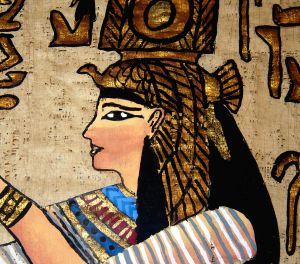Egyptian Goddess Isis
Travel The World

Her name literally means (female) of throne, i.e. Queen of the throne, and the emblem worn on her head was that of a throne. However, the hieroglyph for her name used originally meant (female) of flesh, i.e. mortal, and she may simply have represented deified, real, queens.
Her origins are uncertain but are believed to come from the Nile Delta; however unlike other Egyptian deities she did not have a centralised cult at any point throughout her worship. First mentions of Isis date back to the 5th dynasty which is when the first literary inscriptions are found, but her cult became prominent late in Egyptian history, when it began to absorb the cults of many other goddesses. It eventually spread outside Egypt throughout the Middle East and Europe, with temples to her built as far away as the British Isles. Pockets of her worship remained in Christian Europe as late as the 6th century.
The Egyptian hieroglyphs for her name are commonly transliterated as js.t. As a convenience, Egyptologists pronounce it as ee-set or the more correct ee-sa (the final 't' in Her name was a feminine determinative which was unpronounced) Modern pronunciation is theoretical although echoes of the original pronunciation remain in Coptic (which is the "surviving" form of the Egyptian language) The name was pronounced as (?)-vowel(?)-s-vowel-t (with ? representing the glottal stop), and the actual vowels, as well as the sounds of the consonants, have likely fluctuated throughout 3,000 years of the Egyptian language's spoken history.
By this period, temples to Isis begin to spread outside of Egypt. In many locations, particularly Byblos, her cult takes over that of worship to the Semitic goddess Astarte, apparently due to the similarity of names and associations. During the Hellenic era, due to her attributes as a protector, and mother, and the lusty aspect originally from Hathor, she was also made the patron goddess of sailors.
Throughout the Graeco-Roman world, Isis becomes one of the most significant of the mystery religions, and many classical writers refer to her temples, cults and rites. Temples to Isis were built in Iraq, Greece, Rome, even as far north as England where the remains of a temple were discovered at Hadrian's Wall. At Philae her worship persisted until the 6th century, long after the wide acceptance of Christianity.